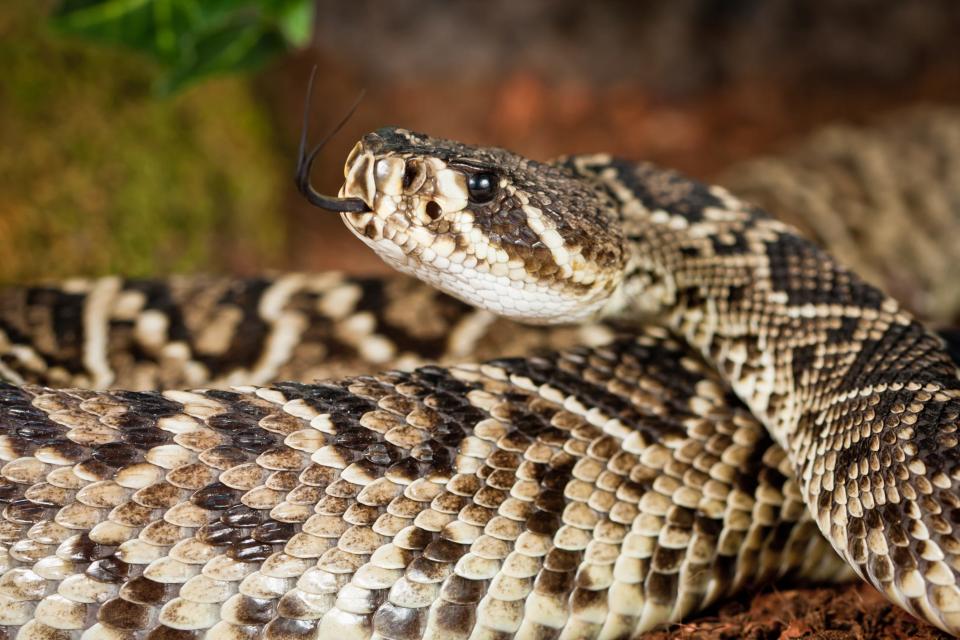Campbell Vaughn: A rare sighting of the Eastern diamondback rattlesnake
Ophidiophobia is real and I have seen it first-hand. You can also watch about ten thousand videos of people jumping out of the skin when encountering the culprit of this excessive angst.
What is an ophio one might ask? It is the Greek word for a snake.
I am not scared of snakes, but admit that I have been startled plenty of times by chance encounters with snakes and have had plenty of these “meetings” over the years.
When I was a teenager, my dad had me crawl under his office to run a cable from the front office where his computer was to the back of the building where the printer was. This was pre-wireless printing so it had to have an actual cable to connect. The office was an old downtown building with a decent sized crawl space except for all the duct work impeding easy movement. As I was wiggling my way between the metal duct and the dirt floor, Dad yells “can you see it?” “It” being the cable I was supposed to be looking for and all of a sudden, a slender black cord was bouncing up and down and all I saw was what looked like a black snake next to my head and I literally had nowhere to go.
Georgia snakes: Here's what species live in the Peach State, venomous snakes
Getting back to nature? Experts offer outdoor tips for hikers, hunters, leaf-peepers
You talk about panicked. When I realized it wasn’t a snake and just a printer cord, I reached around to find my heart and put it back in my chest, rubbed my forehead that I hit on the floor joist and grabbed the printer cable to finish the job. I understand ophidiophobia.
Eastern diamondback rattlesnakes is the largest of the over 30 species of rattlesnake
Why all the snake talk? Last weekend on the way out to a dove field in Sylvania, my friend Keri spotted a snake I have only seen one other time in the wild: a giant Eastern diamondback rattlesnake. We stopped to admire it from a distance and let him ease back into the woods.
It was at least five feet plus in length and absolutely beautiful. The markings and colors were incredible. And what made it such a big event for me was that we were in the presence of North America’s longest and heaviest venomous snakes. The one we saw was no slouch.

The Eastern diamondback rattlesnake is the largest of the over 30 species of rattlesnake. They are heavy-bodied snakes with very broad heads. Adults are usually 3-6 feet long, with the largest on record being 96 inches (8 feet) and can weigh in at over 10 lbs. According to my favorite herpetology website from UGA’s Savannah River Ecology Laboratory (srelherp.uga.edu), the range of the Eastern diamondback rattlesnakes are restricted to the Lower Coastal Plain of the Southeast, from southern North Carolina to eastern Louisiana, although the stronghold of their range is in Florida and southern Georgia.
Augusta is on the northern side of the diamondback’s range, so spotting them in our immediate area is rare. They are usually found in dry sandy areas, palmetto or wiregrass flatwoods, pinewoods, coastal dune habitats, or hardwood hammocks. This dry sandy pine habitat is where we were dove hunting, so our rattlesnake was in the right area.
Generally found in more upland area, they can sometimes live along the edges of swamps. They are known to be good swimmers and travel through saltwater to and from barrier islands. Eastern diamondbacks rely heavily on the burrows of the only tortoise found in the southeast which is the gopher tortoise (Gopherus polyphemus). This is especially true during hibernation in the winter months.
Diamondbacks feed almost exclusively on mammals. When younger, meals include mice, rats and birds, but as they mature their major staple is rabbits. Mating occurs in the spring and fall and females give birth to 12 – 24 young each brood. Also interesting is that rattlesnakes don’t lay eggs, but give live births. Diamondbacks are slow to mature but can live up to 25 years. Adult females only reproduce every two to three years.
The Eastern diamondback rattlesnake are not protected in Georgia and South Carolina, but are definitely declining in numbers. North Carolina does have all rattlesnakes in a protective status, but the Eastern diamondback has not been spotted there since the early 1990s.
Rattlesnake roundup festivals have been a culprit of decline for the diamondbacks throughout the Southeast although many of the longtime festivals have turned their attention environmental awareness over collecting and destroying habitat. The invasion of the wild hog, car tires and belt making haven’t help the diamondback numbers either.
It is so cool to get to witness something as renowned as the Eastern diamond rattlesnake. I know I have an appreciation for the beauty of this creature…from a safe distance for sure.

Reach Campbell Vaughn, the UGA Agriculture and Natural Resource agent for Richmond County, by e-mailing augusta@uga.edu.
This article originally appeared on Augusta Chronicle: Eastern diamondback rattlesnake incredible but under threat | Column

